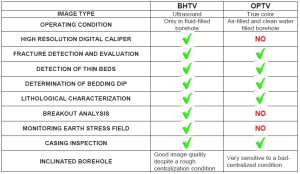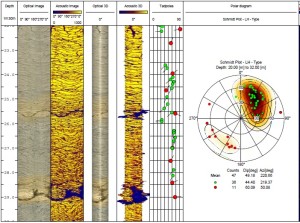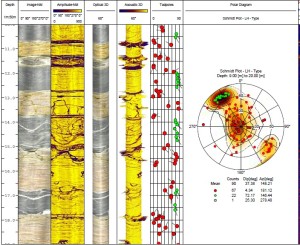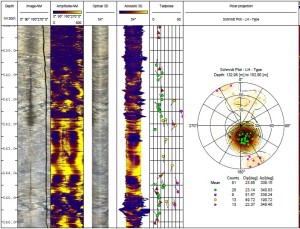G. Piffer, M. Rinaldi, Waterstones Srl
Geophysical Well log represents a powerful tool for the geomechanical analysis and in general to detect cavities and fractures.
To achieve this goal is possible to use two different devices: the acoustic televiewer and the optical televiewer. In the geomechanical analysis, the used optical camera, is also named as ‘optical scanner’. It’s a slightly different tool from an inspection televiewer normally applied in water wells.
The acoustic camera (BHTV) returns amplitudes and travel times as a ultrasonic image while the optical scanner (OPTV) returns true colors images. Scanning is done in a circular manner and laterally for both devices.
Both tools need to be centralized on the borehole during the run. In case of the hole diameter exceed the nominal diameter the tool could lose the correct position at the expense of data quality.
Acoustic and Optical televiewer data are complimentary tools especially when the purpose of the survey is the structural analysis.
A common data display option for both devices is the projection on a ‘virtual core’ that can be rotated and viewed from any angle. The obtained images will complement and even replace coring survey and its associated problem of core recovery and orientation.
Acoustic televiewer is operating only in fluid-filled borehole, even in high turbidity condition as muds. The optical televiewer is working only in air filled borehole and clear water condition.
An advantage of the acoustic televiewer is to measure the diameter of the borehole through the use of the digital caliper, very useful tool in volumetric calculations.
The next images (Fig.1-3) show the records, for both devices, of the same depth range at the same borehole. The examples are been recorded for different rock types and conditions. It can be noted how the devices will highlight different geomechanical properties of the same investigated rock formation.
Fig.1 OPTV and BHTV images of a vertical borehole in sedimentary rock. The sequence is constituted by calcarenite strata with diffuse primary structures.
Fig.2 OPTV and BHTV images of a vertical borehole realized in a metamorphic sequence intruded by sub-horizontal pegmatite bodies.
Fig.3 OPTV and BHTV images of a 40° inclined borehole realized in a paragneiss rock.





